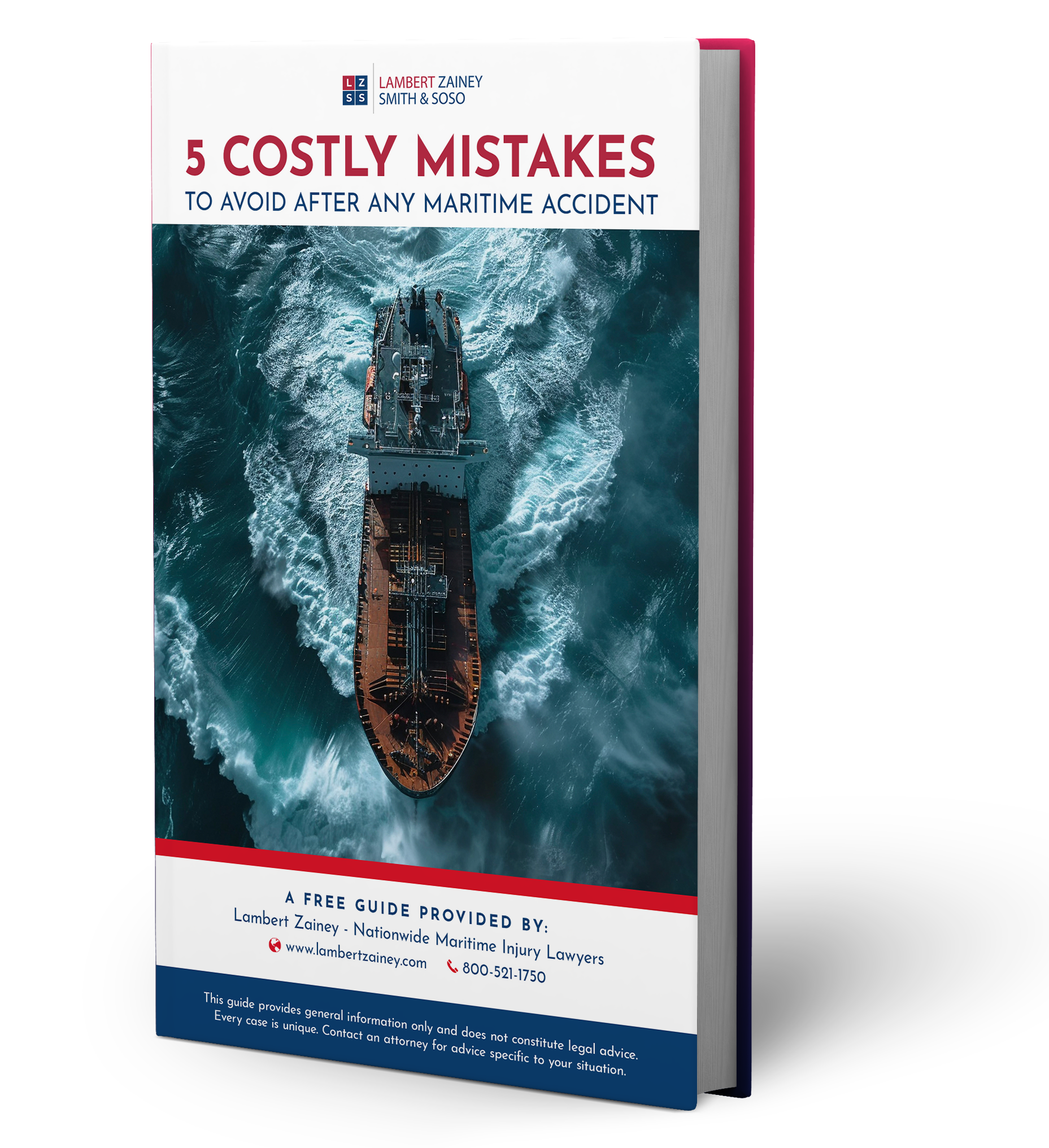The Jones Act and the Longshore and Harbor Workers’ Compensation Act (LHWCA) are two federal laws that protect maritime workers who are injured on the job. Injured maritime workers need to understand the differences between these two acts to ensure they receive the compensation they deserve after a work injury.

These laws offer different protections, different types of compensation, and have different eligibility requirements. It is important for injured maritime workers to understand both acts so that they better advocate for their rights and make sure they receive all of the benefits they are entitled to after an injury or illness occurs on the job.
The Jones Act: History, Who Is Covered, And What Compensation Can Seamen Recover
The Jones Act is a federal maritime law that covers workers who are injured on sea-going vessels on navigable waters and offshore facilities that are not permanently affixed to the ocean floor. The law covers vessel captains and crew members who qualify as seamen.
History and Purpose of the Jones Act
The Jones Act, also known as the Merchant Marine Act of 1920, was enacted to develop and maintain a robust merchant marine. The Act was originally intended to protect the U.S. shipping industry from foreign competition and ensure that American vessels were used to transport goods between U.S. ports.
The Jones Act has also had a significant impact on maritime workers’ rights, particularly those employed on U.S. ships. It grants seamen certain rights to ensure some measure of protection from unfair treatment by employers, and that they receive compensation for any harm caused as a result of their employment.
Who Is Covered by the Jones Act?
To be covered under the Jones Act, a worker must meet the requirements to qualify as a “seaman.” Generally, this means workers who spend 30% or more work time on a vessel or group of vessels in navigation and under common ownership.
Types of Injuries Covered by the Jones Act
The Jones Act covers any injury or illness sustained by a seaman in the course of their job. These may include:
Compensation Available Under the Jones Act
If you are a seaman who was injured at work, you are entitled to maintenance and cure under the Jones Act no matter the circumstances of your injury. These benefits provide for your medical expenses and day-to-day living expenses while you are unable to work.
In addition, employers must provide a safe working environment for seamen. If you are a seaman who is injured as a result of your employer failing to fulfill that obligation, you have a right to bring a negligence claim against your employer under the Jones Act. You may be able to recover damages such as:
The Longshore and Harbor Workers’ Compensation Act (LHWCA)
The Longshore & Harbor Workers’ Compensation Act (LHWCA) is a federal statute that provides benefits for maritime workers who are injured on the navigable waters of the United States but aren’t covered by the Jones Act or state workers’ compensation laws.
History and Purpose of the LHWCA
The LHWCA was enacted in 1927 to provide compensation for lost wages, medical benefits, and rehabilitation services to maritime workers not covered by the Jones Act. It also guarantees payment for reasonable and necessary medical treatment, as well as mileage reimbursement and vocational rehabilitation services.
Who Is Covered by the LHWCA?
The LHWCA covers a wide range of workers who are employed in support of the maritime industry on the navigable waters of the United States or in an adjacent area customarily used in loading, unloading, repairing, or building a vessel. This includes workers such as:
Benefits are not available to Jones Act seamen or government employees.
Types of Injuries Covered by the LHWCA
The LHWCA covers any injuries sustained by a worker that arise out of and in the course of employment. This includes but is not limited to:
Compensation Available Under the LHWCA
Under the Longshore and Harbor Workers Compensation Act, injured workers may be entitled to:
Generally, a worker who is covered by the LHWCA can receive temporary benefits equal to two-thirds of their average weekly wages while they are being treated for an injury.
Key Differences Between the Jones Act and LHWCA
So, now that we have discussed the important points of these two laws as they pertain to workers’ rights, now let’s highlight the key differences between the Jones Act and the LHWCA.
Coverage and Eligibility Requirements
The Jones Act only covers seamen, while the LHWCA provides benefits for maritime workers who are not covered by other maritime laws or state workers’ compensation.
Unlike the LWHCA, a seaman must prove negligence or fault on the part of his or her employer, vessel operators, officers, and/or fellow crewmember to obtain compensation. LHWCA-covered workers need only to prove that the injury occurred on the job and that they were working near navigable waters of the U.S.
Type of Benefits Available
The Jones Act allows seamen to recover compensation for both economic and non-economic damages, while LHWCA benefits are restricted to medical expenses, lost wages, and vocational rehabilitation services. Additionally, the LHWCA does not cover pain and suffering or punitive damages.
Because of this, settlements and damage awards under the Jones Act are often larger than settlements and/or awards under the LHWCA.
Statute of Limitations: Jones Act versus LHWCA
The statute of limitations refers to the time period in which you must bring a legal action. The Jones Act has a three-year statute of limitations. Generally, the LHWCA has a 30 day time limit to file a claim, but that may be extended up to one year in certain cases. This means that injured workers under the Jones Act have more time to bring a claim than those covered by the LHWCA.
Legal Process and Jurisdiction
The Jones Act allows injured workers to sue their employers and other parties for negligence in federal court, while LHWCA claims are generally adjudicated in administrative proceedings.
It’s important to note that each law has its own complexities and nuances, so it is always best to consult with a qualified maritime attorney if you have been injured at work.
Get Our FREE Guide to Protect Your Claim
What you do after an accident is critical. Insurance companies will try to get you to make mistakes that can hurt your claim. Our free guide can help you avoid these traps.
Download our complimentary guide: “5 Costly Mistakes to Avoid After Any Maritime Accident” to arm yourself with the knowledge you need to protect your rights.
Get Help Protecting Your Rights Under the Jones Act & LHWCA
The laws that govern the maritime industry can be complex and confusing. The attorneys at Lambert Zainey are here to help you understand your rights under both the Jones Act and the LHWCA, and to protect them so that you receive the compensation you deserve for any injuries or losses sustained due to negligence.
We have been handling Jones Act and LHWCA cases for more than 40 years and know the ins and outs of maritime claims. If you or a loved one has been injured, contact us today to discuss your legal options.
The Jones Act and the Longshore and Harbor Workers’ Compensation Act (LHWCA) are two federal laws that protect maritime workers who are injured on the job. Injured maritime workers need to understand the differences between these two acts to ensure they receive the compensation they deserve after a work injury.

These laws offer different protections, different types of compensation, and have different eligibility requirements. It is important for injured maritime workers to understand both acts so that they better advocate for their rights and make sure they receive all of the benefits they are entitled to after an injury or illness occurs on the job.
The Jones Act: History, Who Is Covered, And What Compensation Can Seamen Recover
The Jones Act is a federal maritime law that covers workers who are injured on sea-going vessels on navigable waters and offshore facilities that are not permanently affixed to the ocean floor. The law covers vessel captains and crew members who qualify as seamen.
History and Purpose of the Jones Act
The Jones Act, also known as the Merchant Marine Act of 1920, was enacted to develop and maintain a robust merchant marine. The Act was originally intended to protect the U.S. shipping industry from foreign competition and ensure that American vessels were used to transport goods between U.S. ports.
The Jones Act has also had a significant impact on maritime workers’ rights, particularly those employed on U.S. ships. It grants seamen certain rights to ensure some measure of protection from unfair treatment by employers, and that they receive compensation for any harm caused as a result of their employment.
Who Is Covered by the Jones Act?
To be covered under the Jones Act, a worker must meet the requirements to qualify as a “seaman.” Generally, this means workers who spend 30% or more work time on a vessel or group of vessels in navigation and under common ownership.
Types of Injuries Covered by the Jones Act
The Jones Act covers any injury or illness sustained by a seaman in the course of their job. These may include:
Compensation Available Under the Jones Act
If you are a seaman who was injured at work, you are entitled to maintenance and cure under the Jones Act no matter the circumstances of your injury. These benefits provide for your medical expenses and day-to-day living expenses while you are unable to work.
In addition, employers must provide a safe working environment for seamen. If you are a seaman who is injured as a result of your employer failing to fulfill that obligation, you have a right to bring a negligence claim against your employer under the Jones Act. You may be able to recover damages such as:
The Longshore and Harbor Workers’ Compensation Act (LHWCA)
The Longshore & Harbor Workers’ Compensation Act (LHWCA) is a federal statute that provides benefits for maritime workers who are injured on the navigable waters of the United States but aren’t covered by the Jones Act or state workers’ compensation laws.
History and Purpose of the LHWCA
The LHWCA was enacted in 1927 to provide compensation for lost wages, medical benefits, and rehabilitation services to maritime workers not covered by the Jones Act. It also guarantees payment for reasonable and necessary medical treatment, as well as mileage reimbursement and vocational rehabilitation services.
Who Is Covered by the LHWCA?
The LHWCA covers a wide range of workers who are employed in support of the maritime industry on the navigable waters of the United States or in an adjacent area customarily used in loading, unloading, repairing, or building a vessel. This includes workers such as:
Benefits are not available to Jones Act seamen or government employees.
Types of Injuries Covered by the LHWCA
The LHWCA covers any injuries sustained by a worker that arise out of and in the course of employment. This includes but is not limited to:
Compensation Available Under the LHWCA
Under the Longshore and Harbor Workers Compensation Act, injured workers may be entitled to:
Generally, a worker who is covered by the LHWCA can receive temporary benefits equal to two-thirds of their average weekly wages while they are being treated for an injury.
Key Differences Between the Jones Act and LHWCA
So, now that we have discussed the important points of these two laws as they pertain to workers’ rights, now let’s highlight the key differences between the Jones Act and the LHWCA.
Coverage and Eligibility Requirements
The Jones Act only covers seamen, while the LHWCA provides benefits for maritime workers who are not covered by other maritime laws or state workers’ compensation.
Unlike the LWHCA, a seaman must prove negligence or fault on the part of his or her employer, vessel operators, officers, and/or fellow crewmember to obtain compensation. LHWCA-covered workers need only to prove that the injury occurred on the job and that they were working near navigable waters of the U.S.
Type of Benefits Available
The Jones Act allows seamen to recover compensation for both economic and non-economic damages, while LHWCA benefits are restricted to medical expenses, lost wages, and vocational rehabilitation services. Additionally, the LHWCA does not cover pain and suffering or punitive damages.
Because of this, settlements and damage awards under the Jones Act are often larger than settlements and/or awards under the LHWCA.
Statute of Limitations: Jones Act versus LHWCA
The statute of limitations refers to the time period in which you must bring a legal action. The Jones Act has a three-year statute of limitations. Generally, the LHWCA has a 30 day time limit to file a claim, but that may be extended up to one year in certain cases. This means that injured workers under the Jones Act have more time to bring a claim than those covered by the LHWCA.
Legal Process and Jurisdiction
The Jones Act allows injured workers to sue their employers and other parties for negligence in federal court, while LHWCA claims are generally adjudicated in administrative proceedings.
It’s important to note that each law has its own complexities and nuances, so it is always best to consult with a qualified maritime attorney if you have been injured at work.
Get Our FREE Guide to Protect Your Claim
What you do after an accident is critical. Insurance companies will try to get you to make mistakes that can hurt your claim. Our free guide can help you avoid these traps.
Download our complimentary guide: “5 Costly Mistakes to Avoid After Any Maritime Accident” to arm yourself with the knowledge you need to protect your rights.
Get Help Protecting Your Rights Under the Jones Act & LHWCA
The laws that govern the maritime industry can be complex and confusing. The attorneys at Lambert Zainey are here to help you understand your rights under both the Jones Act and the LHWCA, and to protect them so that you receive the compensation you deserve for any injuries or losses sustained due to negligence.
We have been handling Jones Act and LHWCA cases for more than 40 years and know the ins and outs of maritime claims. If you or a loved one has been injured, contact us today to discuss your legal options.









